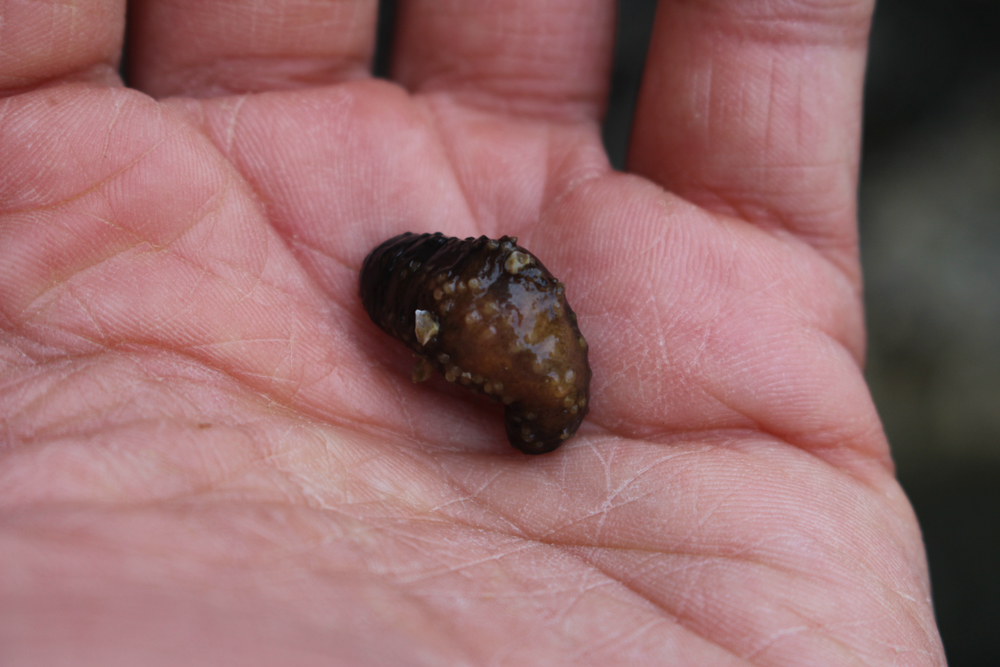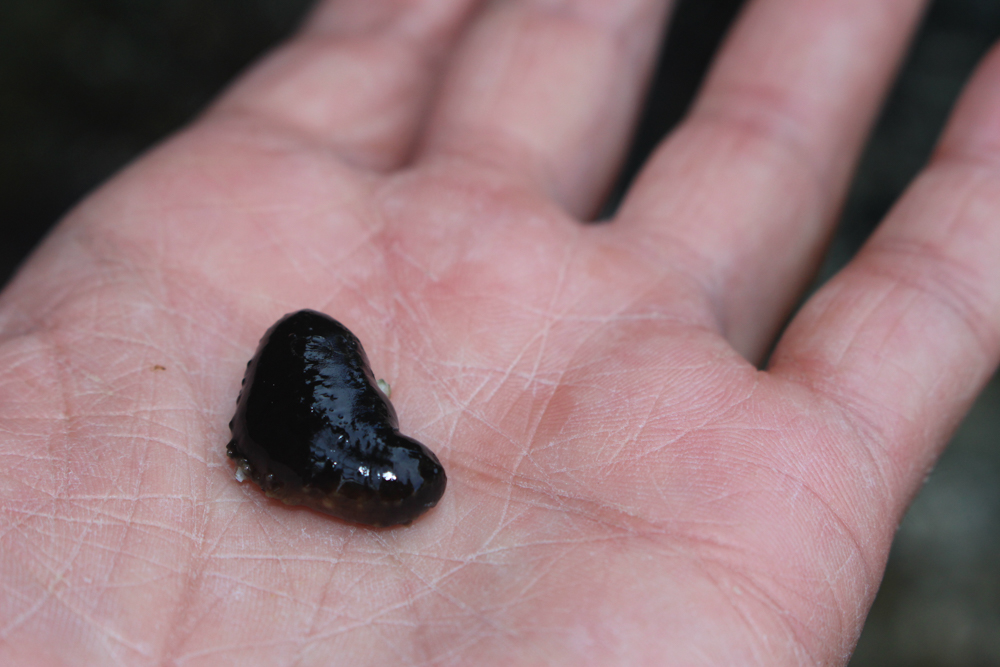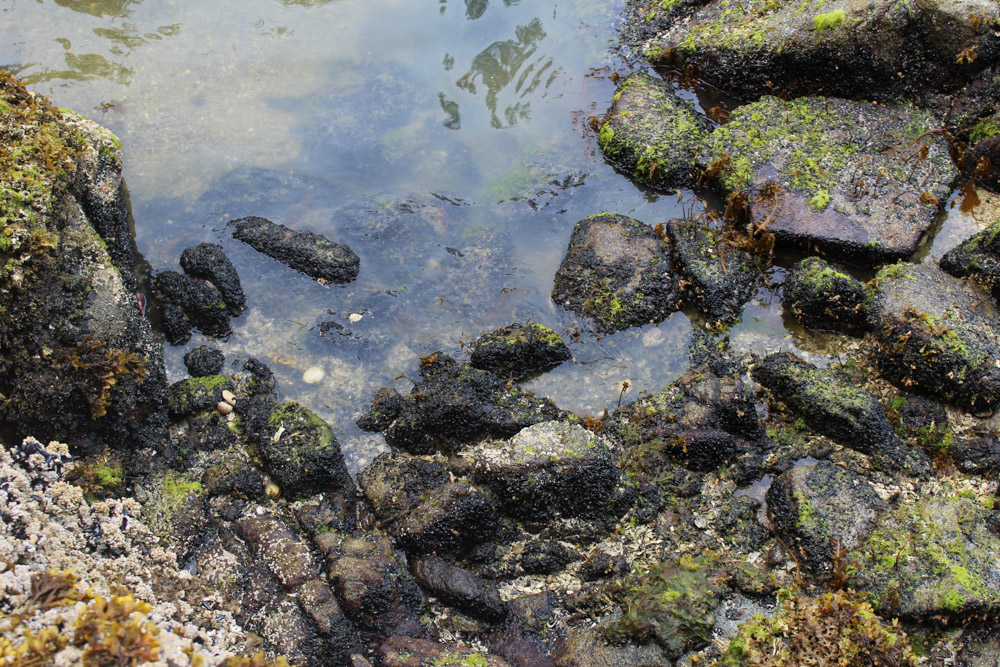Tar spot sea cucumber • Cucumaria pseudocurata
{pseudo = false, in reference to the similar species Pseudocnus curatus; curata = to care for, in reference to egg brooding—though this trait is not specific to the tar spot sea cucumber}
|
Bottom: tar spot sea cucumbers aggregating in the rocky intertidal of a sheltered beach. All the dark/black patches in the bottom right image are sea cucumber-covered rocks. Top: note the defined lines of retracted tube feet on this tiny individual, which is small even for this miniscule species (left is ventral view, right is dorsal). Photos by Sara Wickham.
|
Identification
This tiny sea cucumber reaches a maximum length of only 3.5 cm, and most are between 1.5 to 3 cm. It can appear two-toned, with a greyish-yellow or light brown to dark brownish-black dorsal side, and a white to brown ventral side. It has five well-defined bands of tube feet, arranged in straight or zig-zagged rows. Of the tar spot sea cucumber's ten tentacles (which surround the mouth at the anterior end), eight are equal in size and two, on the ventral side, are smaller.
Habitat & Range
The tar spot sea cucumber forms large aggregations in the mid to low intertidal, and is often found nearby or nestled among California mussel beds, or among corraline algae. It can be locally abundant, and may be found on exposed and protected outer coast shorelines. Its range extends from northern British Columbia to Monterey Bay, California.
Similar Species
The most similar species found on the Central Coast is Pseudocnus curatus, commonly called the black, brooding, or aggregating sea cucumber. The best way to tell the two apart is to take a close look at tentacles (if not retracted) and tube feet: P. curatus has ten tentacles of equal size, and its dorsal tube feet are scattered instead of in rows. It is found in the low intertidal and subtidal, and appears to be restricted to the most exposed shorelines on the outer coast.
In northern BC this species could be confused with the tiny black sea cucumber (Cucumaria vegae), also called the northern tar spot. The two are essentially identical in external morphology, and the internal trait that does vary between the species--ossicle shape—does not provide clear distinction either, as it changes gradually between Alaska and BC. Analysis of mitochondrial DNA indicates such a small degree of genetic difference (around 2%) that they may in fact be northern and southern forms of the same species. Currently both species are still recognized; Lambert suggests identifying specimens south of Haida Gwaii as C. pseudocurata and those from Haida Gwaii and north as C. vegae.
Intriguing Info
Spawning occurs in winter. Males release sperm in strings of mucous. Once a female's bright orange eggs are fertilized she traps the eggs between her body and the substrate, where they remain for two to three months as they develop into juveniles.
This tiny sea cucumber reaches a maximum length of only 3.5 cm, and most are between 1.5 to 3 cm. It can appear two-toned, with a greyish-yellow or light brown to dark brownish-black dorsal side, and a white to brown ventral side. It has five well-defined bands of tube feet, arranged in straight or zig-zagged rows. Of the tar spot sea cucumber's ten tentacles (which surround the mouth at the anterior end), eight are equal in size and two, on the ventral side, are smaller.
Habitat & Range
The tar spot sea cucumber forms large aggregations in the mid to low intertidal, and is often found nearby or nestled among California mussel beds, or among corraline algae. It can be locally abundant, and may be found on exposed and protected outer coast shorelines. Its range extends from northern British Columbia to Monterey Bay, California.
Similar Species
The most similar species found on the Central Coast is Pseudocnus curatus, commonly called the black, brooding, or aggregating sea cucumber. The best way to tell the two apart is to take a close look at tentacles (if not retracted) and tube feet: P. curatus has ten tentacles of equal size, and its dorsal tube feet are scattered instead of in rows. It is found in the low intertidal and subtidal, and appears to be restricted to the most exposed shorelines on the outer coast.
In northern BC this species could be confused with the tiny black sea cucumber (Cucumaria vegae), also called the northern tar spot. The two are essentially identical in external morphology, and the internal trait that does vary between the species--ossicle shape—does not provide clear distinction either, as it changes gradually between Alaska and BC. Analysis of mitochondrial DNA indicates such a small degree of genetic difference (around 2%) that they may in fact be northern and southern forms of the same species. Currently both species are still recognized; Lambert suggests identifying specimens south of Haida Gwaii as C. pseudocurata and those from Haida Gwaii and north as C. vegae.
Intriguing Info
Spawning occurs in winter. Males release sperm in strings of mucous. Once a female's bright orange eggs are fertilized she traps the eggs between her body and the substrate, where they remain for two to three months as they develop into juveniles.
References
Cowles, D. (2006). Pseudocnus curatus (Cowles, 1907). Invertebrates of the Salish Sea. Rosario Beach Marine Laboratory. Accessed 30/11/2015.
Lamb, A., and Hanby, B. (2005). Marine Life of the Pacific Northwest [electronic version]. Madeira Park, BC: Harbour Publishing.
Lambert, P. (1997). Cucumaria pseudocurata Deichmann, 1938b. In Klinkenberg, Brian. (Ed.) E-Fauna BC: Electronic Atlas of the Fauna of British Columbia. Lab for Advanced Spatial Analysis, Department of Geography, University of British Columbia, Vancouver. Accessed 30/11/2015.
Watanabe, J. M. (2012). Cucumaria pseudocurata Deichmann, 1938. SeaNet: Common Marine Organisms of Monterey Bay, California. Stanford University, Stanford, CA. Accessed 30/11/2015.
Authors and editors of page
Kelly Fretwell (2015).
Cowles, D. (2006). Pseudocnus curatus (Cowles, 1907). Invertebrates of the Salish Sea. Rosario Beach Marine Laboratory. Accessed 30/11/2015.
Lamb, A., and Hanby, B. (2005). Marine Life of the Pacific Northwest [electronic version]. Madeira Park, BC: Harbour Publishing.
Lambert, P. (1997). Cucumaria pseudocurata Deichmann, 1938b. In Klinkenberg, Brian. (Ed.) E-Fauna BC: Electronic Atlas of the Fauna of British Columbia. Lab for Advanced Spatial Analysis, Department of Geography, University of British Columbia, Vancouver. Accessed 30/11/2015.
Watanabe, J. M. (2012). Cucumaria pseudocurata Deichmann, 1938. SeaNet: Common Marine Organisms of Monterey Bay, California. Stanford University, Stanford, CA. Accessed 30/11/2015.
Authors and editors of page
Kelly Fretwell (2015).







